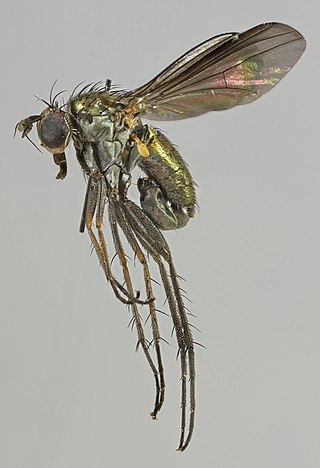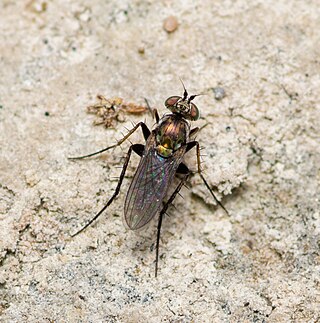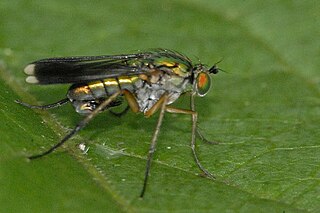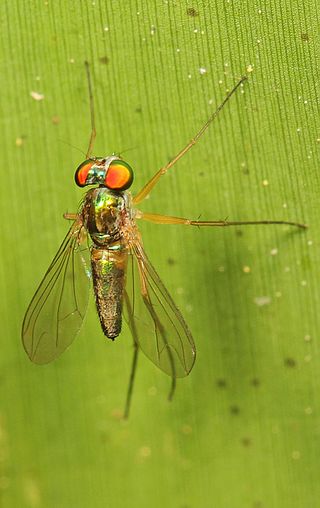
Dolichopodidae, the long-legged flies, are a large, cosmopolitan family of true flies with more than 8,000 described species in about 250 genera. The genus Dolichopus is the most speciose, with some 600 species.

Dolichopus is a large cosmopolitan genus of flies in the family Dolichopodidae. Adults are small flies, typically less than 8 mm in length. Nearly all species are metallic greenish-blue to greenish-bronze. It is the largest genus of Dolichopodidae with more than 600 species worldwide.

Hercostomus is a genus of flies in the family Dolichopodidae. It is a large genus, containing more than 483 species worldwide. Multiple studies have shown that Hercostomus is a polyphyletic assemblage of species.
Nepalomyia is a genus of flies in the family Dolichopodidae.

Paraclius is a genus of flies in the family Dolichopodidae. It is currently considered a polyphyletic assemblage of species.

Sybistroma is a genus of flies in the family Dolichopodidae. It includes over 50 species, described mainly from the Palaearctic and Oriental realms. A single species is known from the Afrotropical realm. Until 2005, the genus was thought to be restricted to the Mediterranean in distribution, with five known species. It was recently expanded to include the former genera Hypophyllus, Ludovicius and Nodicornis, as well as some species of Hercostomus.
Urodolichus is a genus of fly in the family Dolichopodidae. It is known from the Afrotropical realm, Indomalayan realm and Australasian realm. It has been placed in either Rhaphiinae or Diaphorinae, though Grichanov & Brooks (2017) consider the genus to be incertae sedis within the family Dolichopodidae.

Sciapodinae is a subfamily of flies in the family Dolichopodidae. Members of the subfamily possess several ancestral characteristics of the family, such as branched vein M1+2 in the wings (though M2 is absent or reduced in Mesorhagini) and a pedunculate hypopygium. They also typically have a deeply excavated vertex, giving their heads the appearance of a dumbbell when viewed from the front.

Dolichopodinae is a subfamily of flies in the family Dolichopodidae.

Diaphorinae is a subfamily of flies in the family Dolichopodidae.

Medeterinae is a subfamily of flies in the family Dolichopodidae.
Ahercostomus is a genus of flies in the family Dolichopodidae. It currently contains only one species, Ahercostomus jiangchenganus, known only from China. Ahercostomus was originally created as a subgenus of Hercostomus; it was later promoted to genus rank by Zhang & Yang (2005). Alternatively, Brook (2005) provisionally regards Ahercostomus as a synonym of Hercostomus.

Peloropeodinae is a subfamily of flies in the family Dolichopodidae. In some classifications, the genera of the subfamily are included in Sympycninae. According to a molecular phylogenetic analysis of the family Dolichopodidae by Germann et al. (2011), the subfamily is polyphyletic.

Gymnopternus is a genus of flies in the family Dolichopodidae. It was formerly placed as a subgenus of Hercostomus, but is now accepted as a separate genus.

Poecilobothrus is a genus of flies in the family Dolichopodidae.
Setihercostomus is a genus of flies in the family Dolichopodidae, known from China, Taiwan, Russia and Tanzania.

Sciapodini is a tribe of flies in the family Dolichopodidae.

Chrysosomatini is a tribe of flies in the family Dolichopodidae.

Sinosciapus is a genus of flies in the family Dolichopodidae. It is known from China.












